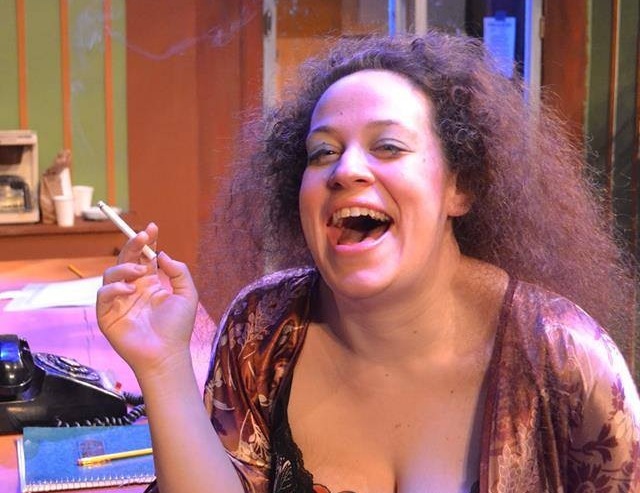STAGES at Camden County College’s professional production of THE HOT L BALTIMORE is forceful at times–full of energy at the beginning and calm at the end. That’s okay. It’s supposed to be.
Director Marjorie Sokoloff proves this production of Lanford Wilson’s play has all the symptoms associated with a Bipolar Disorder—or to use the term from the seventies—Manic-Depressive disorder, which seems to me more descriptive of play’s nature. The characters are at once interesting, pathetic and we are sympathetic. I’m sure the playwright intended for us to see them that way.
While I found this production’s intensity early on a bit over the top, the ensemble’s ability to talk at the same time at the same high pitch was amazing. It is hard enough to memorize lines, but even harder to say them at the same time everyone is saying their lines.
The play is a difficult one, and the cast was up to the task. Each member had moments when the stage was all his or hers. Sanity and insanity was the order of the day. The cut-away set and sound design by Donald Swenson was perfect, as was the John Curall’s lighting. With the excellent music segues, the audience was primed for each act to begin.
Lanford Wilson’s off-Broadway comedy, THE HOT L BALTIMORE, ran for 1666 performances. In 1973, the play won an Obie Award and the Drama Critics’ Circles Award for Best American Play.
In 1975, producer Norman Lear adapted the play for a half-hour ABC sitcom that had several controversial elements for its time: two primary characters who were prostitutes, one an illegal immigrant and one of the first gay couples to appear on an American television series. Although the network supported the show, it failed to win an audience and canceled it after thirteen episodes.
“Hôtel Baltimore,” the French version, was produced for television in 1976; however it, too, lasted for only a single season.
In case you are wondering, the neon light spelling “HOT L BALTIMORE” with the “E” that was not replaced reflects the seediness of the derelict hotel. It may mean something else as well. Could the missing “E” be symbolic of something that is missing, not only from the hotel, but also in the people who live there? It is an unusual play in that the emphasis is on a “place” and “character” rather than story or plot.
The manager strives unsuccessfully to maintain a semblance of order despite the fact his world is literally falling down around him. The action of the play takes place in the hotel lobby where the residents, through their interactions, help us explore our relationship with space that is close to us, and with each other. However, it is a bit too loud I think. At first, there is loud and obnoxious shouting, then shouting that does not give you a headache, and finally, a resolve of sorts with a state of near calm. The play ends, but we know it will be the same tomorrow. That is the point.
Naturally, the residents do not see the run-down hotel the way we see it. Not only are they connected to it as their common abode, they have unwittingly bonded with each other. Their cantankerous fellow residents are all quirky in some way—call it bipolar disorder run amok–, yet they are more at home at the Hotel Baltimore than they would be anywhere else. It has become a part of who they are as well. We meet a diverse group of characters who are old and young, strong and weak. Some remain fixed, defiantly resisting eviction, while are others are more resigned to their fate. These characters run the gamut of emotions—with varying degrees of intensity. Some even appear normal.
We all know about cause and effect. This is not so much “cause” as it is “place”– and effect. We know the longing to stay in a familiar accommodation when we know logically we have to leave whatever the reason.
There are no lead parts here. Our hearts are with the character ensemble.
The drama is of passing events in their lives, of everyday conversation (shouting)-our interactions with others– and of the human comedy. Wilson’s opinion seems to be that we have—perhaps, unknowingly–lost the ability to be interested in others’ lives as well as our own. The playwright thinks that is important. His view of society seems as relevant today as it did in 1973.The characters remind us, poignantly, of our need to talk and discuss who we are or what we want out of life instead of shouting our disapproval at each other’s faults.
Through its diverse characters, THE HOT L BALTIMORE presents a mosaic of lives, no matter how “seedy,” that strives for acceptance. They are, after all, a part of humanity as well as the rest of us.
It is adult theatre for the harsh language, sexual situations and innuendo and nudity. The nude scene is tastefully performed, but the fact is “tastefully” performed makes you wonder that every other situation is in your face—why not that? It struck me as odd, although the towel fight was fun. Toned down, the scene was not particularly shocking or delivered with same abruptness as I think the playwright intended it to be. Although nudity in the theatre is somewhat passé these days, it fits with the other vulgarities found in the play.
STAGES’ bipolar production of THE HOT L BALTIMORE was interesting and entertaining. Be sure to see it before it’s run is finished. The STAGES at CCC’s company did a terrific job with an unusual play.
THE HOT L BALTIMORE
Written by Pulitzer-Prize Winner Lanford Wilson
Directed by Marjorie Sokoloff
March 1, 6, 7 and 8, 2014 at 8:00 PM
March 2 at 3:00 PM
STAGES at Camden County College
Little Theatre
311 College Drive
Blackwood, NJ 08012
(856) 227-7200
www.stagesccc.com/


